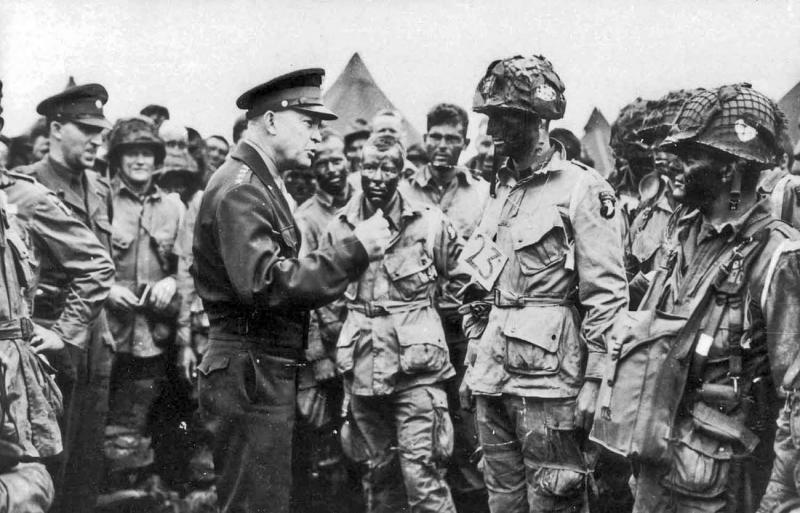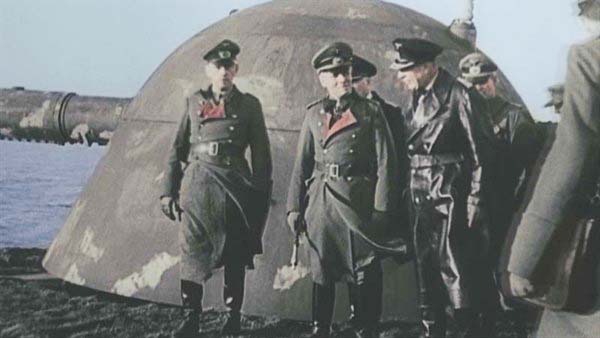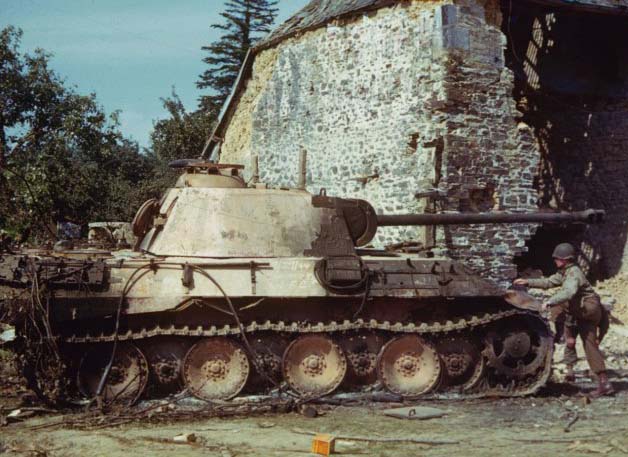D-Day Sacrifice, National Geographic | reviews, news & interviews
D-Day Sacrifice, National Geographic
D-Day Sacrifice, National Geographic
Classic archive footage portrays the Normandy invasion, with added colour

With the 70th anniversary of D-Day following hard on the heels of the extensive World War One commemorations, battle fatigue is becoming a very real concern for TV-watchers.
Although this was a multinational collaborative effort, the premise was straightforward. The two one-hour films told the invasion story via news footage shot before, during and after the landings, most of it of astoundingly high quality, and it had been digitally converted from the original black and white into colour. Even in the wake of a movie like Saving Private Ryan, which brought home the terror and chaos of the battlefield with hideous intensity, this real-life archive material delivered galvanising shocks of its own (below, German commander Erwin Rommel inspects the Normandy defences). Robert Capa's startling still photos from Omaha Beach lent an additional frisson of actualité.
 The tale of the elaborate planning for the Normandy invasion, with its massing of forces in southern England and cunning ruses to convince the Germans that the real target was the Pas-de-Calais, has been told often enough, but scenes of paratroopers blackening their faces with boot polish before roaring off to be dropped in darkness behind the German front lines before the invasion began made real the near-suicidal nature of the exercise. Over footage of American troops clambering into landing craft in unpleasantly choppy seas off the Normandy coast, we heard the words of GI Samuel Fuller (the future movie director), wondering if posterity would record the way the decks of the boats were covered in so much vomit it was like walking on an ice-rink. We heard Fuller's words again as the troops struggled off their boats towards the beach - "I swallow a ton of water, mixed with American blood."
The tale of the elaborate planning for the Normandy invasion, with its massing of forces in southern England and cunning ruses to convince the Germans that the real target was the Pas-de-Calais, has been told often enough, but scenes of paratroopers blackening their faces with boot polish before roaring off to be dropped in darkness behind the German front lines before the invasion began made real the near-suicidal nature of the exercise. Over footage of American troops clambering into landing craft in unpleasantly choppy seas off the Normandy coast, we heard the words of GI Samuel Fuller (the future movie director), wondering if posterity would record the way the decks of the boats were covered in so much vomit it was like walking on an ice-rink. We heard Fuller's words again as the troops struggled off their boats towards the beach - "I swallow a ton of water, mixed with American blood."
If some scenes looked superficially familiar from previous WW2 documentaries, it was if they'd just been black and white trailers for the real thing assembled here. There was a lengthy scene of Canadians landing at Bernières-sur-Mer, and you felt like you were jostling elbow to elbow with them and sharing their ghastly sensation of helplessness as the German gunners opened fire. In footage of Americans trapped at the base of the cliffs on Omaha Beach, the shock and exhaustion on their faces made words unnecessary. A glimpse of human entrails slopping around inside a landing craft was merely unspeakable.
 There was some remarkable material from the German side too. We saw SS tank regiments carrying grinning teenagers from the Hitler Youth towards the beaches to try to fight off the invaders, and the camera looked straight down the barrel of German guns firing at Allied fighter-bombers as they thundered low overhead (wrecked German tank, above).
There was some remarkable material from the German side too. We saw SS tank regiments carrying grinning teenagers from the Hitler Youth towards the beaches to try to fight off the invaders, and the camera looked straight down the barrel of German guns firing at Allied fighter-bombers as they thundered low overhead (wrecked German tank, above).
But it wasn't all shooting and explosions. There were voice-over accounts from French civilians who watched it all happen with a mixture of terror and euphoria, while the diaries of Kay Summersby, General Eisenhower's chauffeur, gave a cool and analytical insider's perspective (although the bit where she described an intimate encounter with the Supreme Commander raised the temperature somewhat). There was a glimpse into the future shape of post-war Europe too, as the climactic account of the liberation of Paris ended with General de Gaulle marching towards Notre Dame cathedral, rubber-stamping himself as the triumphant embodiment of liberated France. D-Day Sacrifice trenchantly evoked just what momentous days these were.
The future of Arts Journalism
You can stop theartsdesk.com closing!
We urgently need financing to survive. Our fundraising drive has thus far raised £49,000 but we need to reach £100,000 or we will be forced to close. Please contribute here: https://gofund.me/c3f6033d
And if you can forward this information to anyone who might assist, we’d be grateful.

Subscribe to theartsdesk.com
Thank you for continuing to read our work on theartsdesk.com. For unlimited access to every article in its entirety, including our archive of more than 15,000 pieces, we're asking for £5 per month or £40 per year. We feel it's a very good deal, and hope you do too.
To take a subscription now simply click here.
And if you're looking for that extra gift for a friend or family member, why not treat them to a theartsdesk.com gift subscription?
more TV
 I Fought the Law, ITVX review - how an 800-year-old law was challenged and changed
Sheridan Smith's raw performance dominates ITV's new docudrama about injustice
I Fought the Law, ITVX review - how an 800-year-old law was challenged and changed
Sheridan Smith's raw performance dominates ITV's new docudrama about injustice
 The Paper, Sky Max review - a spinoff of the US Office worth waiting 20 years for
Perfectly judged recycling of the original's key elements, with a star turn at its heart
The Paper, Sky Max review - a spinoff of the US Office worth waiting 20 years for
Perfectly judged recycling of the original's key elements, with a star turn at its heart
 The Guest, BBC One review - be careful what you wish for
A terrific Eve Myles stars in addictive Welsh mystery
The Guest, BBC One review - be careful what you wish for
A terrific Eve Myles stars in addictive Welsh mystery
 theartsdesk Q&A: Suranne Jones on 'Hostage', power pants and politics
The star and producer talks about taking on the role of Prime Minister, wearing high heels and living in the public eye
theartsdesk Q&A: Suranne Jones on 'Hostage', power pants and politics
The star and producer talks about taking on the role of Prime Minister, wearing high heels and living in the public eye
 King & Conqueror, BBC One review - not many kicks in 1066
Turgid medieval drama leaves viewers in the dark
King & Conqueror, BBC One review - not many kicks in 1066
Turgid medieval drama leaves viewers in the dark
 Hostage, Netflix review - entente not-too-cordiale
Suranne Jones and Julie Delpy cross swords in confused political drama
Hostage, Netflix review - entente not-too-cordiale
Suranne Jones and Julie Delpy cross swords in confused political drama
 In Flight, Channel 4 review - drugs, thugs and Bulgarian gangsters
Katherine Kelly's flight attendant is battling a sea of troubles
In Flight, Channel 4 review - drugs, thugs and Bulgarian gangsters
Katherine Kelly's flight attendant is battling a sea of troubles
 Alien: Earth, Disney+ review - was this interstellar journey really necessary?
Noah Hawley's lavish sci-fi series brings Ridley Scott's monster back home
Alien: Earth, Disney+ review - was this interstellar journey really necessary?
Noah Hawley's lavish sci-fi series brings Ridley Scott's monster back home
 The Count of Monte Cristo, U&Drama review - silly telly for the silly season
Umpteenth incarnation of the Alexandre Dumas novel is no better than it should be
The Count of Monte Cristo, U&Drama review - silly telly for the silly season
Umpteenth incarnation of the Alexandre Dumas novel is no better than it should be
 The Narrow Road to the Deep North, BBC One review - love, death and hell on the Burma railway
Richard Flanagan's prize-winning novel becomes a gruelling TV series
The Narrow Road to the Deep North, BBC One review - love, death and hell on the Burma railway
Richard Flanagan's prize-winning novel becomes a gruelling TV series
 The Waterfront, Netflix review - fish, drugs and rock'n'roll
Kevin Williamson's Carolinas crime saga makes addictive viewing
The Waterfront, Netflix review - fish, drugs and rock'n'roll
Kevin Williamson's Carolinas crime saga makes addictive viewing
 theartsdesk Q&A: writer and actor Mark Gatiss on 'Bookish'
The multi-talented performer ponders storytelling, crime and retiring to run a bookshop
theartsdesk Q&A: writer and actor Mark Gatiss on 'Bookish'
The multi-talented performer ponders storytelling, crime and retiring to run a bookshop

Add comment